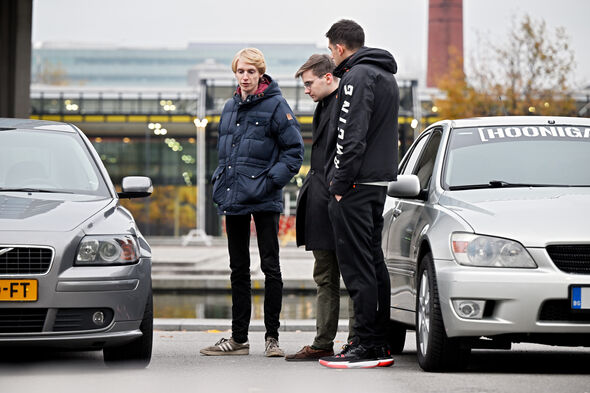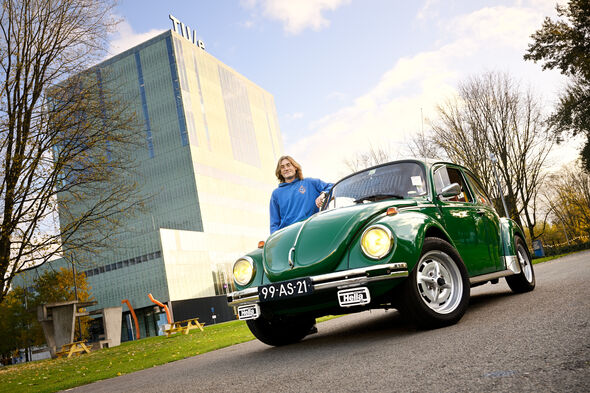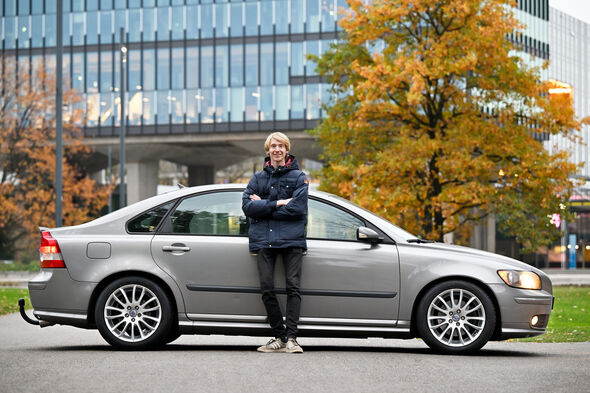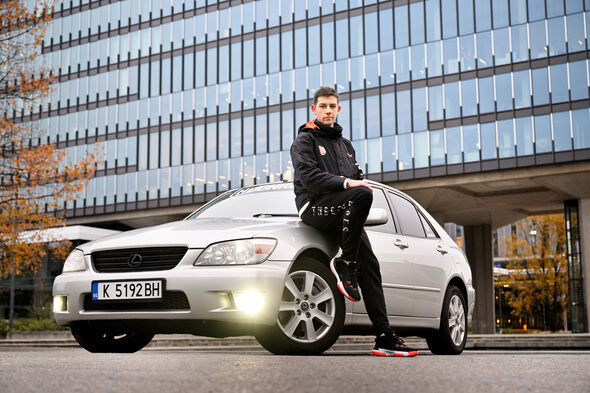
Students share their love for Beetles, Volvos and tinkering with cars
Many members of student association E.S.A.V. de Beunbazen have their own car
What started as a WhatsApp group of six students with a shared love for cars, grew into a 130-member association in the course of four years. E.S.A.V. de Beunbazen now also has its own workshop, located in the city center. Members of the association talk about what it’s like being a beunbaas and having your own car.
It’s dark already when the first students arrive and park their cars at business park Park Forum for a meeting of E.S.A.V. de Beunbazen. Every single car in this neatly lined up row on the parking lot is a unique specimen. But what makes these cars really special, is the passion, enthusiasm and money invested in them by their owners, practically all of whom are students. Apart from this parking lot, they also get together daily in their own workshop in the middle of town to talk about – well, what else – cars.
The student association for car enthusiasts, which started with twelve members in 2018, has grown significantly, and continues to grow, founder Harald List says. “We have about 130 members now.” This increase in membership numbers is something he had hoped for, but never expected to happen. “It took a lot of effort and many meetings to keep everything up and running. But just look at all the different car models we have here now. Sometimes we have a super car in our midst, parked next to a rusty 1991 Volkswagen Polo. But there’s a good chance that everyone will flock around that Polo.”
That’s because the focus at E.S.A.V. de Beunbazen doesn’t lie with who has the most expensive, fastest or loudest car, but on a shared passion and knowledge, and on working on cars together. That mostly takes place in a workshop close to the city center, which the Beunbazen have been renting since last year. That workshop was discovered, literally by accident, by Simon Bergman, who is in charge of the organization’s external affairs. “I had driven my Volvo – which is named Junior by the way, and used to be owned by two other members of our association before me – into a tree. As I was working on my car in the middle of the street, a passer-by told me that he could arrange a workshop through some people he knew, and that I could work there during the Christmas holidays. The owner of the workshop told me that he was looking for new tenants, and I brought him into contact with the association.”
Contribution
The owner was prepared to rent out the place against a fair price, because he liked the fact that students would be making use of it, and because he could stop by for a cup of coffee on occasion. Bergman: “We then decided to organize a large fundraising event for members, and asked companies, such as the local snack bar and a car part shop, to contribute financially. That’s how we managed to amass a year’s rent.” Today, due to the workshop, membership contribution has tripled to seventy euros. “A major change, but you get your money’s worth. The workshop also has a bridge, for example; it costs fifty euros a day if you rent one in a garage. When you take that into consideration, seventy euros isn’t that much money.” Members are always welcome to work on their car in the association’s workshop. Apart from that, E.S.A.V. de Beunbazen holds general meetings there as well as drinks, and allows its members to watch Formula 1 races and play video games.
But on this chilly evening, the students came to the Park Forum, simply because this industrial estate has more space. It’s a public space, which means that the students can meet here without any problems. “People in the neighborhood sometimes call the police because of noise nuisance, but that’s not caused by us,” List says. “Sometimes, people come passing by in their cars at high speed because they see us with our cars. They are the ones causing nuisance. The police know that and they know us by now. They know that we won’t do anything irresponsible, and they sometimes come over for a chat.”
A yellow Volvo station wagon comes driving around a corner. Its owner doesn’t have a driver’s license yet, be he lets other association members drive his car. One of the Beunbazen’s traditions is to pack as many people as possible into a car. A video shows at least thirteen members crawling out of a car after yet another attempt at a record. “So much fun,” List says. Members also play jokes on each other during meetings, by hiding exhaust pipes or removable steering wheels, for example. The jokes are always friendly though, according to the students. And they spend just as much time repairing exhaust pipes and other parts, Bergman says. “We all take a look, and someone will say: ‘oh, I still have some lubricating oil lying around somewhere,’ or: ‘I have a wrench we could use.’ Someone might have jumper cables, someone else a tool kit.”
The Beunbazen have been operating very independently since the beginning, most of its members come from TU/e and Fontys. The association is currently in talks with Scala, the umbrella organization for cultural associations, in an attempt to strengthen the ties between the association and TU/e. “We are still figuring out how we can collaborate and really contribute something to that community,” Bergman says. “We already thought about a cabrio concert together with the music associations, or speed chess on the backseat of a driving car; it’s a challenge, but some of the ideas are fun, or pretty insane sometimes.” Whether or not the association will find shelter under Scala’s wings: students – with or without a car – definitely know where to find the Beunbazen. After a meeting during TU/e’s most recent intro week, some 30 to 35 people immediately decided to sign up, Bergman says. “There is a lot of enthusiasm among people to join. People like the place. So do I, these really are my kind of people.”
Many members of E.S.A.V. de Beunbazen own a car, including Harald List, Lars van Hattum and Atanas Gerdzhilov. They talk to Cursor about what it’s like having your own car as a student.
Harald List
Car: Volkswagen Beetle 1303S from 1973 (named Marvin)
Harald List’s Volkswagen Beetle had been rusting away in someone’s backyard for eighteen years when he heard about the car five years ago. The chassis was rotten away, and a bamboo bush had grown through several places. “I was eighteen years old at the time and had just finished my final exams. The car was mine for three hundred euros. There was practically nothing left of the car, and I scraped of ten liters of rust. I still have a video of that, where you hear me cursing in the background and kicking against the car, after which another chunk of rust falls down.”
His father, who also owns an old-timer, had already taught him a few things about tinkering with cars. “You just start to strip it apart and see: hey, this is supposed to move, but it doesn’t. You then work your way through the entire mechanism and learn that there’s a piece of broken rubber.” But he decided to send the car to Hungary for the major repairments. There, the car was paint stripped at a fair price, welded and painted again. “I simply didn’t have the means to that here.” The old-timer returned to the Netherlands practically unrecognizable. Together with his father, List then turned his attention to the car’s interior.
Old-timers
List’s passion for old-timers was instilled in him as a child. His specific interest lies in the odd and obscure Volkswagen Beetle. “That car has character. Its engine, for example, is in the back and is air-cooled instead of water-cooled. And it has horizontally opposed cylinders, unlike normal cars. It’s a total package of strange ideas, with a 1930s design that has never changed. What I like about it, is that it’s so different.”
How does he finance his expensive hobby? “Don’t ask,” he answers. He works in an auto parts and supplies shop two days a week, where he gets to buy parts at a purchase price. He almost never drinks, to save money. And his friends at DUO make a contribution now and then, he says with a whisper. The petrol prices of around 2 euros per liter steadily decrease his bank account. “Every time my car is parked in the street, I fear that someone will steal it. People offer me money for it, sometimes as much as 25,000 euros, but this is my everything.”
Baby
The car took much hard work and energy, which is partly why it feels like a baby to List. “It got me through many things, including the difficult times after my parents’ divorce. I also made new friends thanks to the car. And people in the street always give me a thumbs up. No, I’ll never sell this car.” Not even when petrol cars will be banned in the future. It would be possible to convert his Beetle into an electric car, but List doesn’t want to do that, because the car’s technology is exactly what makes it so charming. “They will have to physically drag me from the car when I won’t be allowed to drive it anymore.”
Lars van Hattum
Cars: Volvo S40 from 2004 (Sven) and Volvo 244 from 1977 (Olle)
Lars van Hattum doesn’t have one, but two Volvos parked in front of his door, both of which he bought during the past three months. He bought the first and youngest of the two, the Volvo S40, because he needed a more reliable mode of transportation to get him from his parents’ home in Zutphen to Eindhoven. “I wanted a Volvo because of its five-cylinder engine, which has a specific drumming sound. Only Volvos and certain Audis have that engine. The engine reminds me of my childhood, when I sat on the backseat of our family car, which also had an engine like that. It was a place of calmness on that backseat. Nothing was expected of me, and we were almost always driving towards somewhere fun.” That memory is linked not just to the car’s sound, but also to its atmosphere and interior. “The whole package is very soothing.”
That quiet exterior is why many people tend to underestimate the car’s power, Van Hattum says. “People sometimes stop for a traffic light in the lane next to me because they think they’re faster. It’s fun to pull up for while next to certain types, only to push the gas pedal and see them disappear in your rear-view mirror. Even if you press the pedal only slightly, you’re still faster” On his way Eindhoven, he sometimes takes a detour via the German Autobahn to feel his Volvo’s power and to see whether it can still reach its top speed of 250 kilometers per hour. “A 260 pk engine easily gets you to 250 kilometers per hour. The car also has a nice sports suspension. It manages just fine.”
Rusty
Apart from that eighteen-year-old S40, Van Hattum also bought a 45-year-old Volvo 244 recently. He drove two similar classic Volvos during his first meeting with the Beunbazen, and he immediately knew that the wanted to buy one for himself. “A fellow member told me a about an add on Marktplaats for this car, and I instantly went ahead and bought it. It was a bit rusty, but in rather good condition all in all.” Despite their age difference, both cars have elements that give them that typical Volvo energy, Van Hattum says. “But the 244 has a few elements that are typical of an old car, such as the lack of power-assisted steering, and that makes driving fun. It’s not easy to steer the 244, especially when you’re parked, you really need muscles for that. It gives it what we jokingly refer to as a boat feeling, in fact, the car even resembles a boat somewhat.”
Having two cars also means having to pay insurance twice. “You do however pay less insurance than you do for modern cars. I believe that’s because people treat old-timers much more carefully than their normal car. I also don’t need to pay road tax.” For now, the student manages to make ends meet with a side job. “It helps that I still live with my parents.” At the same time, his car makes him more independent.
Alsace
Now that he has his own car, Van Hattum can join the Beunbazen on vacation. “On my first trip with the association, we went to the Alsace. There were two groups: a relaxed group and one that had fun driving through bends. My car was the fastest in a straight line, so naturally I joined in driving through bends. That didn’t go entirely without problems. The charge air hose came unstuck, probably because it was slightly tuned. Happily, it was fixed within five minutes, enough knowhow around here.”
Atanas Gerdzhilov
Car: Lexus IS200 from 2001 (Larry the Lexus)
Because of his love for Japanese sports cars and drifting (a driving technique where the driver intentionally oversteers, causing the car to slide laterally, ed.), Gerdzhilov decided to buy his Lexus IS200. “It’s a sports sedan from the early 2000s, I love the Japanese cars from that era. When I was young and watched movies and played games these were the cars that I saw, so that was what I always envisioned having a car like that myself. Besides, they are perfect for drifting.” That’s mainly because these cars are so easy to modify, explains the student. “Back in the early 2000s there was an agreement in Japan to not produce powerful cars. All the cars came out of the factory with a maximum of 280 horse power. Engineers then built those cars in such a way that they were easily tuneable to reach higher horse power. Customers could turn the cars into whatever they wanted.”
That’s exactly what Gerdzhilov loves about drifting as well: turning the car into something that it’s essentially not. “Cars are meant to be stable and as safe as possible. They are meant to drive in a straight line. You take all of that away.” Back in Bulgaria, where the student’s from, there are big open spaces where you can drift to your heart’s content. In the Netherlands it’s not that easy. “But I have done two drifting courses here, and want to do a more advanced one.” Still, you can’t really learn to drift, Gerdzhilov says, you need to have a feel for it. “You have it or you don’t.”
Repairing brakes
In the mean time he’s fixing up his car to be his perfect drifting companion. The Lexus is easy to work on, the student says. That also saves him money, because according to him getting someone else to do it would be extra expensive, since Lexus is a premium brand. “I wanted to fix my brakes and asked how much that would cost, they said it would be 1162 euros just for the front brakes. In the end I bought all the parts and fixed them myself, front and back, for 300 euros.”
Gerdzhilov mainly works on his car in the garage of De Beunbazen. “When I’m working on it my thoughts are occupied with the car. When I have a rough day, I just go to the garage. I also meet other members of the association there, we help each other and work together. It’s my favourite part of the day.” Working on the car, but also driving it, is his passion and it makes him forget about everyday problems.
Toy cars
Just like List, the love from cars was passed onto Gerdzhilov by his father, who also loves Japanese cars. “He’d get me toy cars, I actually have a lot of those with me here in the Netherlands. He’d also drive and drift with me in the car and actually let me drive by myself when I was 8 years old. I have to admit it didn’t go very well. I was barely touching the pedals and couldn’t really steer. But yeah, that’s how I got into cars.”






Discussion